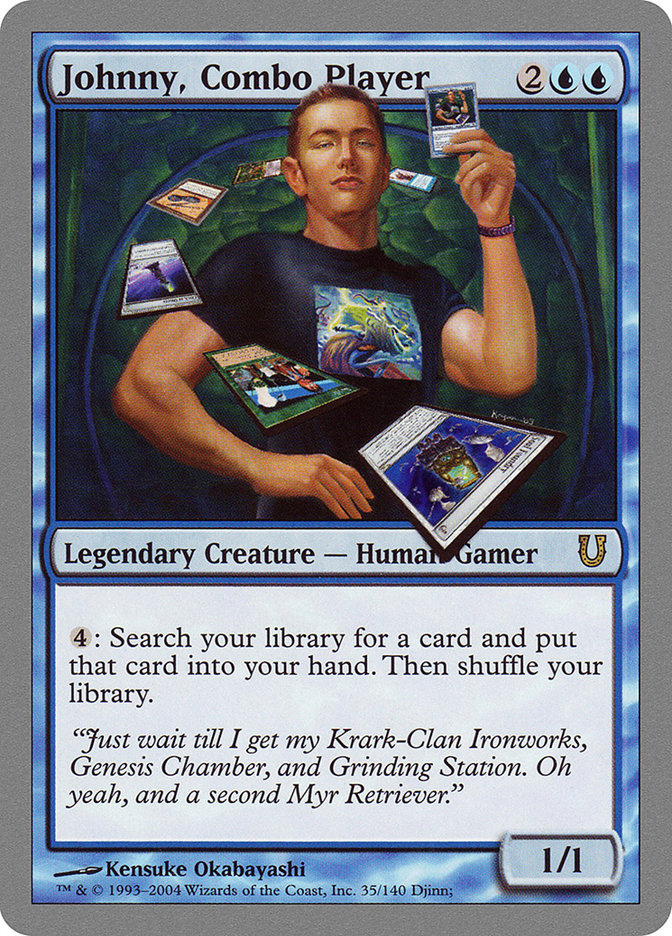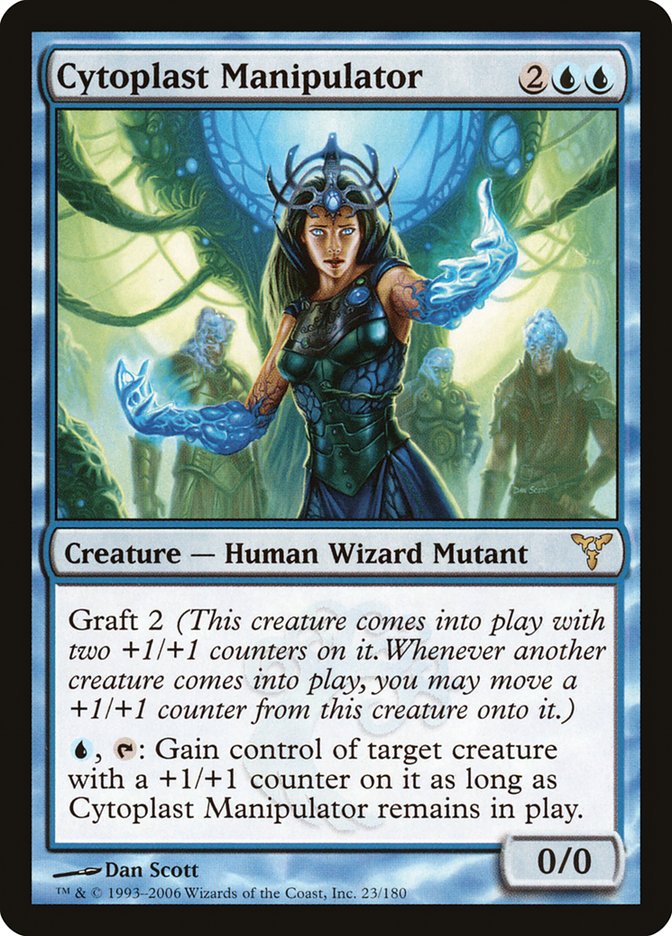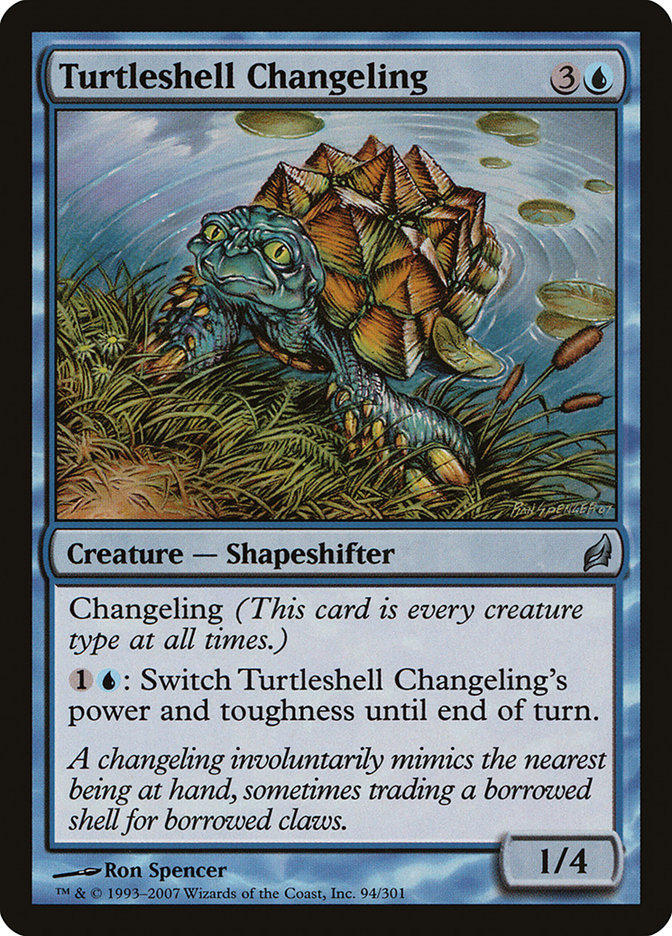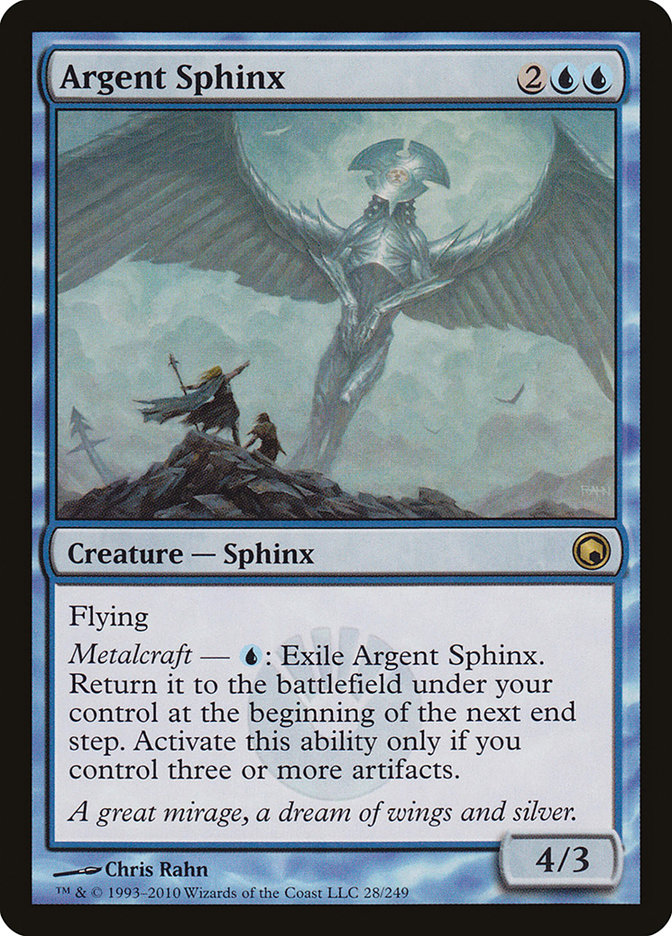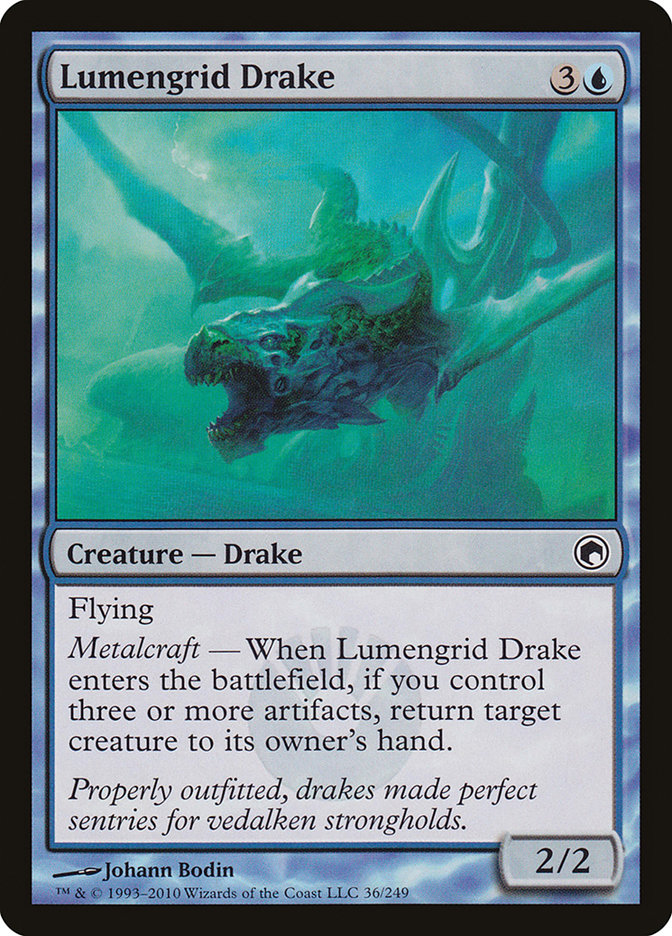Kefnet, dios eterno Carta MTG
| Colecciones da carta | Lanzado en 2 coleccionesVer todos |
| El coste de maná | |
| Costo de maná convertido | 4 |
| Rareza | Mítica |
| Tipo | Criatura legendaria — Deidad zombie |
| Habilidades | Flying |
| Fuerza | 4 |
| Tenacidad | 5 |
Texto de la carta
Vuela. Puedes mostrar la primera carta que robes cada turno en cuanto la robes. Siempre que muestres una carta de instantáneo o de conjuro de esta manera, copia esa carta y puedes lanzar la copia. Cuesta {2} menos lanzar esa copia. Cuando Kefnet, dios eterno muera o vaya al exilio desde el campo de batalla, puedes ponerlo en la biblioteca de su propietario en tercer lugar desde la parte superior.
Cartas Similares
God-Eternal Kefnet agrega un giro único al panteón de criaturas voladoras en Magic: The Gathering. Su parentesco en azul se compara con el estimado Esfinge de la Previsión, ya que ambos son amenazas voladoras de tamaño respetable con habilidades de manipulación de cartas. Sin embargo, Kefnet se distingue por su potencial para lanzar la carta superior de tu biblioteca por un costo reducido si es un instantáneo o conjuro, recordando la habilidad encontrada en Arcanista de Élite. Arcanista de Élite permite exiliar una carta instantánea para lanzarla múltiples veces, pero carece de las cualidades repetitivas y de poder vistas en Kefnet.
Otra carta comparable es Talrand, Invocador del Cielo. Talrand recompensa a los jugadores por lanzar instantáneos y conjuros, similar a la interacción de Kefnet con la parte superior del mazo. Sin embargo, Talrand se enfoca en crear un ejército en expansión de criaturas voladoras, divergiendo del enfoque de Kefnet de valor repetido y resistencia permanente. También podemos mirar a Nezahal, Marea Primal que también sobresale en estrategias azules centradas en cartas, amplificando el poder de robo, aunque no tiene la capacidad de Kefnet para reducir costos u ofrecer recurrencia de mazo.
En última instancia, dentro de la sinergia de mazos de criaturas azules, God-Eternal Kefnet proporciona una combinación convincente de resistencia, lanzamiento de hechizos repetible, y una presencia agresiva que otras cartas en esta categoría luchan por equilibrar pero con sus propios giros únicos.
Cartas similares a Kefnet, dios eterno por color, tipo y coste de maná
Mazos que usan esta carta
Mazos MTG usando Kefnet, dios eterno. Profundiza en la estrategia de los mazos, cartas de aparador, lista de ideas y exportación para jugar en ARENA o MOL.
| # | Nombre | Formato | Arquetipo | Evento |
|---|---|---|---|---|
 | Jeskai Control | Legacy | Jeskai Control | Circuito Legacy Catarinense | Temporada 2024 | Etapa 2 |
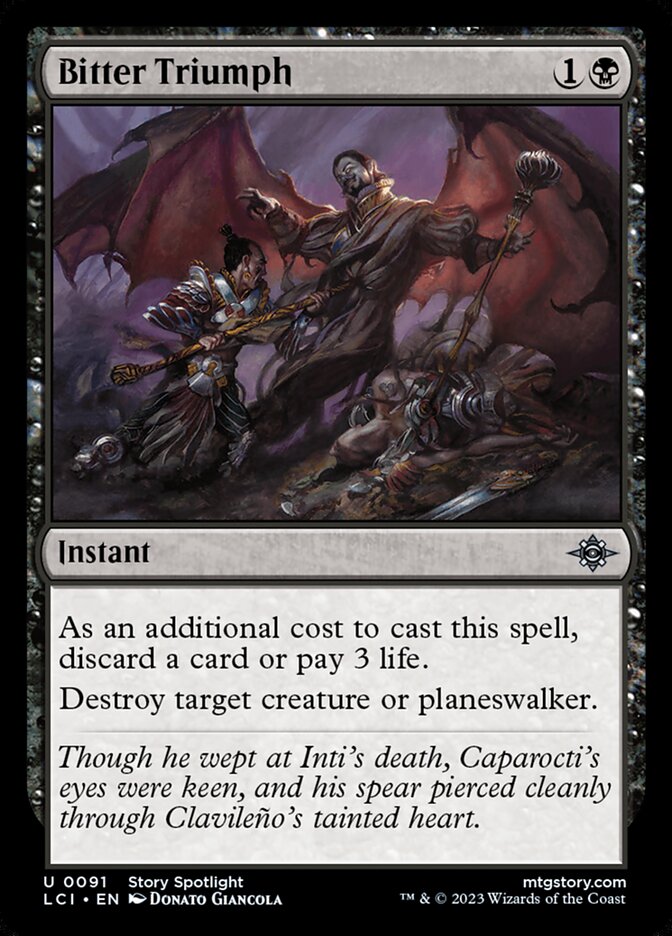 | Grixis Midrange | Gladiator | Gladiator Proving Grounds: Week 13 2024 | |
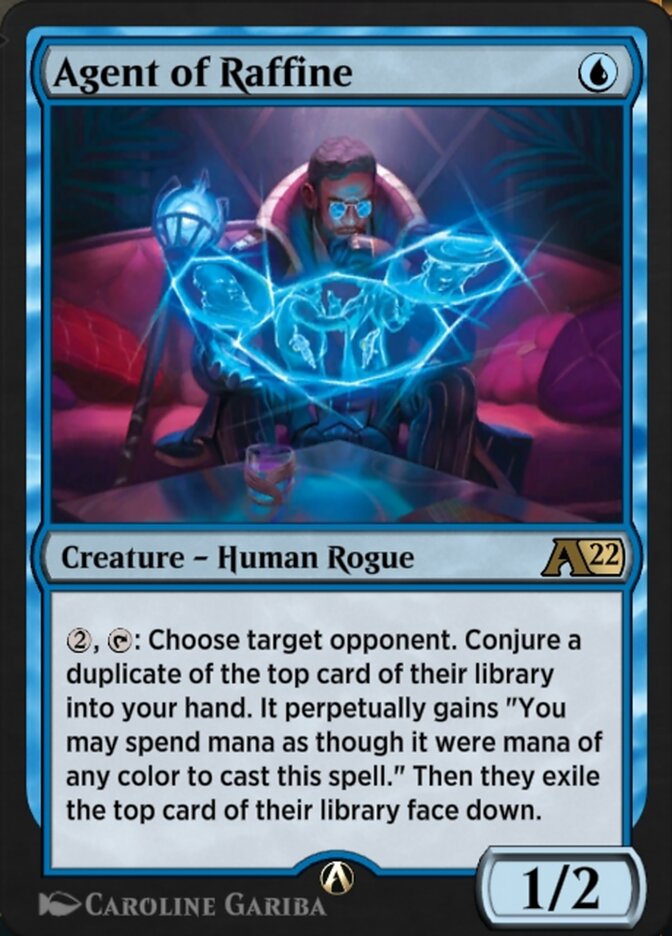 | Izzet Control | Gladiator | Sword and Sandals Showdown: EMEA Week 15 2024 | |
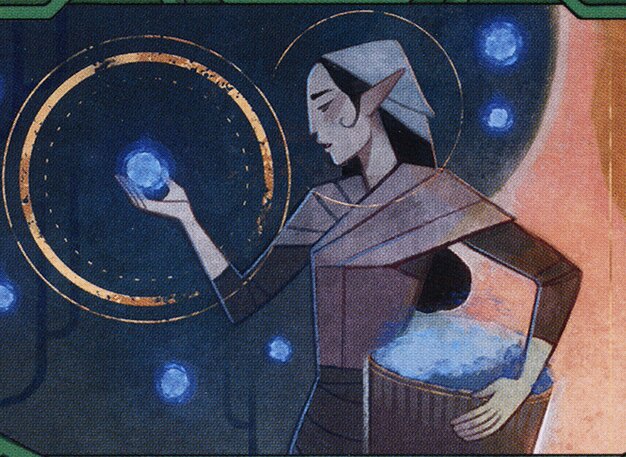 | Temur Control | Gladiator | Gladiator Proving Grounds: Week 14 2024 | |
 | Grixis Tempo | Gladiator | Sword and Sandals Showdown: AM Week 13 2024 | |
 | Sultai Midrange | Gladiator | Sword and Sandals Showdown: EMEA Week 14 2024 | |
 | Bant Control | Gladiator | Gladiator Proving Grounds: Week 12 2024 | |
 | Izzet Tempo | Gladiator | Gladiator Proving Grounds: Week 13 2024 | |
 | Azorius Control | Gladiator | Gladiator Games: We're Back | |
 | Azorius Miracles | Legacy | Jeskai Control | 3 LPL OPEN - SEASON V - LIGA PAULISTA LEGACY |
Ventajas de la carta
Ventaja de cartas: God-Eternal Kefnet otorga un método consistente para obtener superioridad de cartas debido a su habilidad de revelar la primera carta que robas en cada uno de tus turnos y copiar esa carta si es un hechizo instantáneo o de conjuro. Básicamente puedes usar el efecto para lanzar hechizos potentes dos veces, esto puede inclinar rápidamente la balanza a tu favor y abrumar a los oponentes con tu creciente variedad de opciones.
Aceleración de recursos: Aunque no proporciona mana directamente, la habilidad de God-Eternal Kefnet de copiar hechizos instantáneos y de conjuro a un costo reducido acelera la utilización de tus recursos. Esto te permite extender tu mana aún más en cada turno, permitiendo jugadas más eficientes y posiblemente llevando a lanzar múltiples hechizos impactantes mucho antes de lo normal.
Velocidad instantánea: La sinergia de God-Eternal Kefnet con hechizos instantáneos mejora tu flexibilidad táctica. Se te anima a retener mana y seguir siendo una amenaza durante el turno de tu oponente, potencialmente copiando y lanzando hechizos instantáneos poderosos por solo dos de mana. Este enfoque reactivo puede obstaculizar las estrategias de tu oponente a la vez que te mantiene en una posición sólida y adaptable a lo largo del juego.
Desventajas de la carta
Requisito de descarte: La destreza de God-Eternal Kefnet en el campo de batalla es innegable, sin embargo, no viene sin sus inconvenientes. Un aspecto significativo que los jugadores necesitan considerar es cómo interactúa con los mecanismos de descarte. Aunque Kefnet en sí no exige el descarte, prospera con una mano llena, y cualquier descarte forzado puede disminuir su efectividad, dejándote vulnerable.
Costo específico de mana: Invocar el poder de God-Eternal Kefnet requiere un compromiso firme tanto con mana azul como con un total de cuatro puntos de mana. Esta necesidad de doble azul en su estructura de costo podría restringir la diversidad del mazo y complicar las bases de mana, especialmente cuando intentas lanzar varios hechizos en un turno.
Costo de mana comparativamente alto: Comparado con otras opciones, la inversión para jugar a God-Eternal Kefnet es considerable. Para un hechizo de cuatro de mana, los jugadores pueden anticipar un impacto o valor de mesa inmediato, lo cual Kefnet no garantiza siempre, particularmente si no puedes aprovechar su habilidad de copiar hechizos de inmediato.
Razones para incluir en tu colección
Versatilidad: God-Eternal Kefnet prospera en diversos mazos basados en azul, desde control hasta combo, debido a su habilidad de lanzar repetidamente instantáneos y hechizos desde la parte superior de tu biblioteca a un costo reducido. Esto proporciona un valor constante en cada turno y una amenaza resiliente debido a su cláusula de indestructibilidad.
Potencial de combo: Como una criatura legendaria, Kefnet puede habilitar combos que ganan partidas al combinarlo con cartas que manipulan la parte superior de la biblioteca, asegurando que siempre tengas disponibles los hechizos correctos para copiar. Esta sinergia puede aprovecharse para crear jugadas potentes a las que tus oponentes tendrán dificultades para responder.
Relevancia en el meta: En un meta saturado con diversas estrategias, God-Eternal Kefnet se mantiene firme como una carta fuerte en la fase temprana a media del juego que puede interrumpir los planes del oponente mientras proporciona una amenaza constante en el campo de batalla. Su naturaleza recursiva asegura que permanezca como una fuerza en juegos largos e implicados en el intercambio de recursos.
Cómo vencer a God-Eternal Kefnet
Enfrentar a God-Eternal Kefnet puede ser un desafío en el campo de batalla. Como una de las deidades monolíticas en el juego, esta carta tiene la resistencia para regresar a la parte superior de la biblioteca después de morir o ser exiliada. Una estrategia eficiente para romper su ciclo es usar hechizos de velocidad instantánea en respuesta a la habilidad desencadenada. Cartas como Atajar o Fin del Cuento pueden interrumpir la secuencia de retorno de Kefnet, lidiando permanentemente con la amenaza.
Otro enfoque es tomar el control del juego antes de que Kefnet pueda establecer dominio. Cartas que impiden al oponente robar copias extra, como Narset, Compañera de Velos, restringen la habilidad de Kefnet de aprovechar su beneficio de lanzamiento. Las limpiezas de mesa también ofrecen una solución temporal, ya que pueden despejar la mesa mientras te preparas para contrarrestarla en su retorno inevitable.
Para una derrota más duradera, considera explotar efectos que barajan en la biblioteca como Compromiso // Memoria o usar tácticas de interrupción de mano para asegurar que Kefnet sea tratado antes de llegar al campo. Estos métodos requieren una comprensión precisa del tiempo y la secuencia para garantizar la victoria contra este poderoso enemigo.
Recomendaciones de BurnMana
Domina las profundidades intrincadas de MTG implica entender el uso estratégico de cartas como God-Eternal Kefnet. Con sus capacidades de ventaja de cartas, aceleración de recursos y juego a velocidad instantánea, Kefnet puede convertirse en un pilar en los mazos basados en azul. Sin embargo, recuerda sus posibles restricciones debido a costos específicos de mana y la importancia de mantener una mano llena. Al integrar las ideas de sus ventajas, desventajas y comparación con cartas similares, puedes decidir cómo utilizar mejor la fuerza de Kefnet en tu colección, formar estrategias para combatirla y apreciar su lugar en el meta actual. Eleva tu juego y enriquece tu colección explorando las sinergias de God-Eternal Kefnet. Sumérgete más profundamente con nosotros y descubre tu camino hacia el éxito en MTG.
Donde comprar
Si estás buscando comprar una carta MTG Kefnet, dios eterno de un coleccione específico como War of the Spark and War of the Spark Promos, existen varias opciones confiables que debes considerar. Una de las fuentes principales es tu tienda de juegos local, donde a menudo puedes encontrar paquetes de refuerzo, cartas individuales y mazos preconstruidos de colecciones actuales y pasadas. A menudo ofrecen el beneficio adicional de una comunidad donde puedes intercambiar con otros jugadores.
Para un inventario más amplio, particularmente de colecciones más antiguos, mercados en línea como TCGPlayer, Card Kingdom y Card Market ofrecen amplias selecciones y te permiten buscar cartas de colecciones específicos. Las plataformas de comercio electrónico más grandes como eBay y Amazon también tienen listados de varios vendedores, lo que puede ser un buen lugar para buscar productos sellados y hallazgos raros.
Además, el sitio oficial de Magic suele tener un localizador de tiendas y listas de minoristas para encontrar Wizards of the Productos con licencia costera. Recuerde comprobar la autenticidad y el estado de las cartas al comprarlas, especialmente a vendedores individuales en mercados más grandes.
A continuación se muestra una lista de algunos sitios web de tiendas donde puede comprar las Kefnet, dios eterno y otras cartas MTG:
 COMPRAR
COMPRAR BurnMana es un socio oficial de TCGPlayer
- eBay
- Card Kingdom
- Card Market
- Star City Games
- CoolStuffInc
- MTG Mint Card
- Hareruya
- Troll and Toad
- ABU Games
- Card Hoarder Magic Online
- MTGO Traders Magic Online
Ver productos MTG
Impresiones
La carta Kefnet, dios eterno Magic the Gathering se lanzó en 2 colecciones diferentes entre 2019-05-03 y 2019-05-04. Ilustrado por Lius Lasahido.
| # | Liberado | Nombre | Código | Símbolo | Número | Marco | Disposición | Borde | Artista |
|---|---|---|---|---|---|---|---|---|---|
| 1 | 2019-05-03 | War of the Spark | WAR | 53 | 2015 | Normal | Negra | Lius Lasahido | |
| 2 | 2019-05-04 | War of the Spark Promos | PWAR | 53s | 2015 | Normal | Negra | Lius Lasahido |
Legalidades
Formatos de Magic the Gathering donde Kefnet, dios eterno tiene restricciones
| Formato | Legalidad |
|---|---|
| Historicbrawl | Legal |
| Commander | Legal |
| Historic | Legal |
| Legacy | Legal |
| Modern | Legal |
| Oathbreaker | Legal |
| Vintage | Legal |
| Duel | Legal |
| Explorer | Legal |
| Gladiator | Legal |
| Pioneer | Legal |
| Timeless | Legal |
Reglas e información
La guía de referencia para las reglas de las cartas Kefnet, dios eterno de Magic: The Gathering proporciona las reglas oficiales, las erratas emitidas, así como un registro de todas las modificaciones funcionales que se han producido.
| Fecha | Texto |
|---|---|
| 03/05/2019 | Si un efecto destierra al Dios y lo devuelve inmediatamente al campo de batalla, su última habilidad se activa pero no tendrá efecto. Sin embargo, si un efecto lo destierra y lo devuelve al campo de batalla en un momento posterior, la habilidad del Dios puede devolver esa carta a la biblioteca de su dueño primero. Si lo hace, el efecto que lo desterró no lo devolverá más tarde. |
| 03/05/2019 | Si un efecto pone una carta en tu mano sin usar la palabra "robar", la carta no fue robada. |
| 03/05/2019 | Si uno de estos Dioses abandona el cementerio o el exilio mientras su última habilidad está en la pila, permanecerá en su nueva zona, aunque esa zona sea un cementerio o exilio. |
| 03/05/2019 | Si uno de estos Dioses fuera a morir y es tu comandante en la variante Comandante, puedes ponerlo en la zona de mando en su lugar. Si salvas a tu comandante de esta manera, no morirá y no lo pondrás en tu biblioteca. Lo mismo es cierto si fuera a ser desterrado. |
| 03/05/2019 | Si el dueño de Dios tiene dos cartas o menos en su biblioteca, Dios se coloca en la parte inferior de su biblioteca al resolverse su última habilidad. |
| 03/05/2019 | Si la carta sale de tu mano antes de que se resuelva la habilidad desencadenada de Kefnet, la copiarás utilizando su última información conocida. |
| 03/05/2019 | Si controlas al Dios de otro jugador cuando muere, decides si poner esa carta en la biblioteca de su dueño. |
| 03/05/2019 | Si revelas una carta de esta manera, permanece revelada hasta que la habilidad desencadenada de Kefnet termina de resolverse. |
| 03/05/2019 | Si de alguna manera controlas más de un Kefnet Dios Eterno (quizás porque uno es una Doble Chispa), puedes revelar una carta que robes por cualquiera de sus habilidades. De a uno por vez, cada uno copiará la carta si es un instantáneo o conjuro, y puedes lanzar cada uno de ellos. Cada copia se resuelve antes de que lances el siguiente, y el coste de cada copia se reduce solo en . |
| 03/05/2019 | En un juego multijugador, si pones en el campo de batalla bajo tu control al Dios de otro jugador, será exiliado cuando abandones el juego. Si seguías siendo el controlador de ese Dios, controlarías su habilidad desencadenada, pero ya has abandonado el juego; esa habilidad no se resolverá y la carta permanecerá en exilio. De manera similar, si pierdes el juego al mismo tiempo que el Dios de otro jugador que pusiste en el campo de batalla es destruido, permanecerá en el cementerio de su dueño. |
| 03/05/2019 | Es importante revelar la primera carta que saques cada turno (o elegir no revelarla) antes de que se mezcle con las otras cartas en tu mano. Mira la carta mientras la sacas antes de decidir si revelarla. |
| 03/05/2019 | Los múltiples robos de cartas siempre se tratan como una secuencia de robos de cartas individuales. Por ejemplo, si aún no has robado ninguna carta durante un turno y lanzas un hechizo que te indica que robes tres cartas, las robarás una por una. Solo la primera carta robada de esta manera puede ser revelada y copiada con la habilidad de Kefnet. |
| 03/05/2019 | El ejemplar se crea en tu mano y se lanza. |
| 03/05/2019 | Para determinar el costo total de un hechizo, comienza con el costo de maná o costo alternativo que estás pagando, añade cualquier aumento de costo, luego aplica cualquier reducción de costo (como la habilidad de Kefnet). El costo de maná convertido del hechizo permanece inalterado, no importa cuál haya sido el costo total para lanzarlo. |
| 03/05/2019 | Puedes lanzar la copia durante la resolución de la habilidad desencadenada si es un conjuro de conjuro, sin importar de quién sea el turno o en qué fase estés. |
| 03/05/2019 | Solo puedes lanzar la copia cuando se resuelva la habilidad desencadenada de Kefnet. Si no quieres lanzarla en ese momento (o no puedes hacerlo, tal vez porque no hay objetivos legales disponibles), la copia deja de existir. No puedes lanzarla más tarde. |
| 03/05/2019 | Puedes revelar y copiar una carta de instantáneo o conjuro de esta manera en cualquier turno, no solo en el tuyo, si es la primera carta que has robado ese turno. |
| 03/05/2019 | No es necesario revelar una carta extraída si no deseas copiarla en ese momento. |















